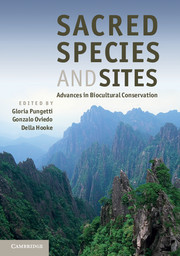Book contents
- Frontmatter
- Contents
- List of Contributors
- Foreword
- Preface
- Acknowledgements
- Introduction
- Part I Concepts and Knowledge
- Part II Sacred Landscapes
- Part III Sacred Sites and People
- Part IV Sacred Species
- Part V Sacred Animals
- Part VI Sacred Groves and Plants
- Part VII Implementation and Conclusions
- 25 Sacred species and biocultural diversity: applying the principles
- 26 Sacred sites, sacred landscapes and biocultural diversity: applying the principles
- 27 Conclusions: the journey to biocultural conservation
- 28 Epilogue: a Spiritual Circle
- Index
- Plate Section
- References
26 - Sacred sites, sacred landscapes and biocultural diversity: applying the principles
from Part VII - Implementation and Conclusions
Published online by Cambridge University Press: 05 August 2012
- Frontmatter
- Contents
- List of Contributors
- Foreword
- Preface
- Acknowledgements
- Introduction
- Part I Concepts and Knowledge
- Part II Sacred Landscapes
- Part III Sacred Sites and People
- Part IV Sacred Species
- Part V Sacred Animals
- Part VI Sacred Groves and Plants
- Part VII Implementation and Conclusions
- 25 Sacred species and biocultural diversity: applying the principles
- 26 Sacred sites, sacred landscapes and biocultural diversity: applying the principles
- 27 Conclusions: the journey to biocultural conservation
- 28 Epilogue: a Spiritual Circle
- Index
- Plate Section
- References
Summary
Introduction
This chapter aims to explore the sacred character of sites and landscapes, illustrating their link with biological and cultural diversity and indicating alternatives for the future with selected case studies. The European and global perspective has been tackled for the discussion, and six boxes by different authors are included to apply the general principles.
The value of protected areas in land and sea as venues of scientific inquiry, nature conservation and destinations for increasingly needed recreation is well known (Harmon and Putney, 2003). Similarly, settings of beautiful and scenic landscapes and their value for biological and cultural diversity are easily appreciated by people (Lucas, 1992). Landscape in particular embraces the ecological, natural, cultural and spiritual values of our environment (Makhzoumi and Pungetti, 1999) and, in turn, has been shaped by people and is a repository of their memories (Schama, 1995); it can be considered a pillar for local identity. The European perspective illustrated in this chapter is a representation of such identity.
The European approach to sacred landscapes
Although sacred landscapes contain important values for different faiths, the predominant link in Europe is with Christianity. However, in several cases, as discussed in Chapter 4, cultural landscapes connected with religions and traditions in Europe and in the Mediterranean basin are often more ancient and were associated with previous beliefs, such as Celts in the North, and Romans, Greeks and Etruscans in the South, rather than with the mainstream faith.
- Type
- Chapter
- Information
- Sacred Species and SitesAdvances in Biocultural Conservation, pp. 407 - 441Publisher: Cambridge University PressPrint publication year: 2012



